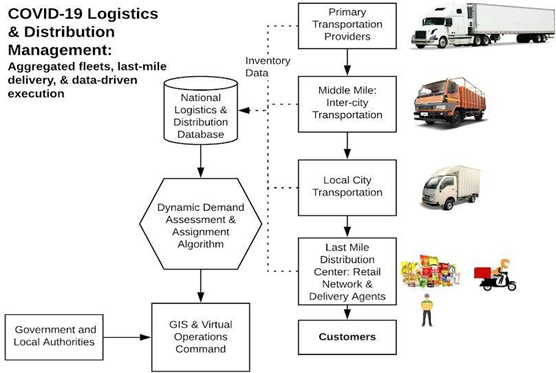
Indian Council of World Affairs
Sapru House, New DelhiRe-defining National Logistics Post Covid-19 India and Global Supply Chains: Opportunity amidst Crisis, 7 August 2020
ICWA organized a virtual discussion on ‘Re-defining Logistics Post COVID-19: India and Global Supply Chains’ on 11 June 2020. The web-based discussion was chaired by Shr. Dilip Chenoy, Secretary-General FICCI and had Shri L.R. Sridhar, Founder, Connect India E-Commerce Distribution Services, Lt. Gen PJS Pannu, PVSM, AVSM, VSM, Former Deputy Chief of Integrated Defense Staff, Parthasarathi Trivedi, CEO, Skylo and Member, CII National Space Committee, Shri Madhav Thapar, Vice-President, South Asia and MD-India, CH Robinson as panelists. Shri N. Sivasailam, Former Secretary (Logistics), Department of Commerce was the lead discussant. The discussion can be viewed here https://youtu.be/QaVMZpITy4c.
Shri LR Sridhar, Lt. Gen. Pannu and Shri Parthasarathi Trivedi have contributed this paper which has been reviewed and edited by Dr. Priyanka Pandit, Research Fellow, ICWA.
With countries around the world imposing lockdowns, minimal export-import movements have amplified the crisis in the logistics space. Logistics & transport sector needs wartime footing to recover to ensure movement of goods & services, vital to keep the economy functioning under the current emergent circumstances. In India, too, under a total lockdown situation, it is imperative to ensure that the country’s transport nervous system for essential goods is strengthened. The present scenario across the domestic sectors is as follows:
- Consumer retail, FMCG, & other essential commodities:
- Basic mobilization of essential goods to millions of households and supply of critical components to the manufacturing sector while under lockdown is in jeopardy.
- >50% of 12-14 million commercial vehicles in operational, since drivers and loaders/unloaders are unavailable.
- Additionally, in many parts of the country, people are resorting to blocking/stopping vehicles, harassing drivers, or seizing essential goods.
- Since >80-90% of the logistics sector in India is unorganized, it comprises temporary labor which has become unavailable as migrant workers return to their villages or otherwise pause work out of fear.
- Net/net, this results in crowding at key points of sale, a lack of effective reach of essential goods & services, and further exposure of the population to COVID-19, which defeats the end objective.
- In the manufacturing sector:
- With global supply chains almost at a standstill, there is a notable paucity in the availability of components in the electronics supply chain, for instance, forcing companies to look internally.
- Lack of commitment to delivery dates, range of more than 4-6 weeks in current ETAs for components which would otherwise be shipped within a week. Vendors in other parts of the world are unable to fulfill supply requirements, though Taiwan and China are ramping up production.
- Though limited air freight corridors are operational, lack of availability of space for movement of goods termed ‘non-essential’.
- India’s manufacturing houses can’t rely on the global supply chain nor the domestic transportation corridors, which was otherwise taken for granted.
- In the agricultural sector:
- Current harvesting season challenges are being faced with shortage of labour, combine harvesters that cannot be moved and movement of food grains to the markets, payment to farmers and movement further to FCI godowns.
- There would be a need for farmers to prepare for the next crop by purchase and mobility of fertilizers and fuel for tractors and pesticides.
- While local intra-city delivery systems are likely to be less impacted, regional and long-distance logistics are significantly impaired.
- This presents a challenge in the supply of essential items, such as such as medicines, masks and ventilators, among several others.
- India’s logistics network needs a strong convergence between industry and government forces, combined with technology to aid in demand/supply matching and a distributed delivery network that leverages neighborhood retail networks as last mile distribution centers.
- Inefficiencies in logistics lead to long journey times, which undermines participation in global value chains.
Recommendation to reinstate Global & National Supply Chain & Logistics:
- To position India as part of the global manufacturing hub and to take advantage of the opportunities thrown up by the Covid-19 pandemic, the Government of India should actively initiate building logistics infrastructure under the “Self-Reliance” objective. As the global and regional supply chains stand disrupted due to the pandemic, the world may look at new options in the post covid period. Also, businesses are reassessing the extent of their firms’ dependency on single foreign suppliers, especially with regard to critical supplies. In this regard, India, carries lot of potential to develop as one of the Global Manufacturing hubs both from a costs and efficiency point of views. For instance, the development of a crisis-proof logistics supply chain that remains operational at all times, may be a criterion preferred in the development of global hubs.
- The logistics industry players form as a coordinated & aggregated force under the authority of a single point of coordination in the central Government, responsible for restoring supply of goods to and from the agricultural, manufacturing, e-commerce, pharmaceutical, and all other key sectors.
- Landing international cargo at Ports and Airports is no good if clearance cannot happen, and clearance is of little relevance if there is no effective distribution and last mile delivery Eco System. Since consumers, both nationally and globally are concerned with timely delivery, any breaks in the chain would not only delay the process but also undermine its participation in the global logistics network.
- Logistics & SCM Industry are also investing increasingly in technology, digitalization and even more value propositions. In order to do so it needs to be allowed to price as per market conditions and with minimal regulations as competition itself will drive a fair level.
- Social distancing requirement will drive more online buying from cross border and hence e-commerce giants will source larger quantities and hold in stock at FTWZ warehouses across India to be closer to market. As a result, FTWZ warehousing and bonded warehousing could see a demand.
- It is important to consider converting Indian Ports into multi country hubs. Developing Free Trade Zones in their immediate vicinity, making major Indian airports into trans-shipment hubs with minimum formalities could help India acquire an international gold standard in air services. Also, opening up off terminal private bonded facilities both for export aggregation and build up as well as import de-consolidation would also enable India to emerge as a modern logistics hub globally.
- This new distribution management ecosystem relies on:
- Data and technology-driven real-time, transparent demand/supply matching.
- The participation of brick & mortar neighborhood stores as the last mile delivery partners.
- The aggregation of small, medium and heavy trucking fleets.
- The participation of commerce platforms to opt-into this ecosystem for consumers and enterprises alike to order from existing sources, and obviate the need to change their existing behavior.
- A nationwide logistics supply inventory or database of participating distributors, logistics providers and retail stores.
- Complete Government ownership to be the coordinating & central authority of this impartial, sector-agnostic distribution system.
- Impressment of transportation services should be invoked as part of essential services where in the transport and logistics companies should be able to give passes to vehicles and drivers under the standing authority of the Govt. All the Company needs is an authorization of being impressed by the Govt of India. Same authority should be able to allow the company to ask for escorts if the situation so demands. Tracking facilities will be able to facilitate alarm systems where logistic convoys need protection with SOS provisions.
- Key principles guiding the formation of this new national distribution system: Velocity able to be implemented expeditiously
- Transparency -- no partiality or bias in choosing any one actor or a group of actors in the system.
- Efficiency -- net cost-saving relative to the unorganized sector working in silos. More efficient demand/supply matching means greater throughput and on-time performance.
- Sustainability -- no ‘quick fix’ solutions which can’t sustainably operate during or post the crisis. The system should evolve to meet the needs of the nation’s logistics needs beyond the crisis.
- Central logistics authority for COVID-safe distribution.
- The industry stakeholders and Governments at the central, state and local levels need to come together under a common central logistics and distribution authority that regulates COVID-safe distribution.
- The central logistics authority would invite participation from distributors/logistics and transport providers commerce platform, and retail stores.
- The central logistics authority would have access to real-time data available, from each leg of the supply chain, to transparently and effectively monitor execution and resolve and bottlenecks in supply -- especially for trucks carrying medicine, agricultural produce, milk and other essentials.
- A command set-up or operations center based on the existing government administrative structure be set up for distribution of essential supplies. Public distribution systems can be co-opted with the retailers by registering more dealers.
- Tracking and real-time monitoring of essential commodities through Regional Command Centers, bulk-breaking points and Mother Warehouses be done though use of networks.
- Online Feedback systems are incorporated to ensure no area is left without supplies.
- Rural areas could be networked through village postal networks with hubs provided by the DOT.
- The aim should be to build sustainable systems as such emergencies may become a norm due to the nature of the calamity that may strike without warning.
- The central logistics authority can ‘call on’ the aggregated pool of distributors and their respective fleets to mobilize essential goods & resources at a time of crisis.
- To fully enable the logistics sector, which comprises of migrant and contractual workers, guaranteeing safety of workers and drivers is paramount to reinstate trust and availability of the workforce. This has to be ensured with access to healthcare / medical checks, complete end-to-end communication with SoS mechanism in commercial vehicles, and insurance for both delivery personnel and their families. Temporary parking areas and crew accommodation can be aligned with the logistics architecture.
- Customer order & demand/supply matching
- Existing online commerce platforms could link to this common emergency distribution ecosystem through for fulfillment of new orders.
- Customers would place online orders for goods & services through the designated portal. The Government GEM could also be co-opted to ensure standardization of pricing.
- Simple online portal for emergencies and regular needs to be established. Emergency supply should have pre-listed inventory, which is most frequently ordered, including critical medicines.
- A dynamic demand assignment algorithm matches demand with supply, and issues orders to the relevant Primary and regional transportation service providers, along with the retail distribution center and delivery agent.
- All transport providers are enabled with live satellite-based tracking, IoT connectivity, and real-time SoS system to enable safety for the drivers and ensure high uptime of the fleets.
- Ubiquitous telemetry data from the vehicles with digital dispatch / driver connectivity is also essential to route and re-route trucks on the road on-demand, and to ensure that the utilization of the existing fleets on the road are maximized.
- The demands should be automatically sanctioned and moved to the regional depots and retailers as per the requirements received online (Pull model).
- Hospital and Medical institutional demand must be met urgently. Similarly demand for ambulances should be on the portal. Ambulances should be available on the UBER Model.

- Delivery: last mile, long-distance & inventory management
- Logistics Players in the Last Mile distribution would provide its network of retailers to a nationwide central ‘inventory’ of logistics supply, and also identify local retailers to participate in this COVID-19 Disaster Distribution Management ecosystem.
- There will be appointed authorized within each pin-code, within 1-2 km radius blocks
- Local delivery personnel can register themselves through an online application to be part of the delivery system, and receive quick virtual training in conducting COVID-safe deliveries.
- The neighborhood delivery personnel can be assigned to cover particular brick & mortar stores, and provided with safety gear and masks to effect deliveries to local customers & other businesses.
- The Government also has existing networks, such as Common Service Centers, which could be opted in to support distribution.
- Suppliers (E-Commerce Company or any other manufacturing company/supplier) would ensure Primary Transportation from their Mother warehouses to the Regional Warehouses by trucks, which would be automatically assigned via the demand/supply matching system.
- Suppliers and distributors would move their respective materials from the regional warehouses to a particular state through small trucks to local warehouses.
- Finally, last-mile delivery partners with small trucks/vans would carry goods to the designated last mile distribution centers, from where the delivery would be fulfilled by the delivery agents/personnel.
- The entire distribution network would need to be provided with COVID-safe handling authorization passes, and the requisite permissions to operate unhindered.
- Payments would be digitally disbursed to each stakeholder in the chain, after accurately pricing each delivery automatically, much like how ride-share apps automatically price each ride prior to execution.
- This system would ensure that the supply chain from last-mile delivery to the end consumer continues to function, while leveraging the unorganized sector and providing livelihood to stores, delivery agents, logistics operators, laborers & drivers across the country.
- Hence it is necessary to create independent working organization in Logistics and supply chain which would include representatives of the key stakeholders involved in the logistics sector, private sector providers and users, technical experts and public sector agencies/companies. The inclusion of experts and stakeholders would help in addressing grievances of the industry, lead to better policy formulations along with regulating, supporting and facilitating growth of industries and trade, both nationally and globally.
- Also, the trade logistics sector needs to be seen not only in the narrow context of goods transport and warehousing but also in the wider role it plays in connecting industrial sites to different nodes along trade corridors, enabling the creation of a logistics sector capable of offering the diverse and high-quality services along the global value chains.
*****
Lt. Gen. PJS Pannu (PVSM, AVSM, VSM, former Dy Chief Integrated Defence Staff), Mr. L.R. Sridhar (Founder Connect India E-Commerce Distribution Services) and Parthsarathi Trivedi (Member, CII National Space Committee & CEO, Skylo)
Disclaimer: Views expressed are personal.















